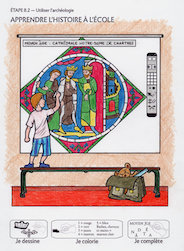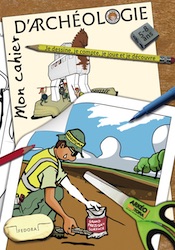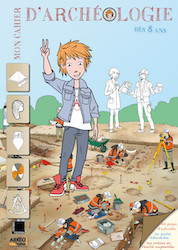Archaeology in Everyday Life: History Class
- Last Updated: Tuesday, 28 June 2022 10:08
- Published: Friday, 15 April 2022 08:11
- Written by Jean-Olivier Gransard-Desmond translated by Leah Gallet and Maura Schmitt
- Hits: 2933
Join Augustin, Alex, Lisa and the entire ArkeoTopia team to discover additional resources for step 8.2 in My Archaeology Book on the practical applications of archaeological research, such as teaching history at school.
Step 8.2 - Practical Applications of Archaeology
History Lessons at School
Corresponding pages in MAB1 and MAB2
MAB 1 p. 36 and MAB 2 p. 44
More about this step’s reference artifact

 For this reason, neither Alex nor Lisa are depicted in this image, and instead we see a young schoolboy using an interactive whiteboard (IWB). The IWB is recognizable by its toolbar on the right-hand side. The young schoolboy colors the stained glass in order to understand the color distribution and to fill in the missing parts of the design, just as your student will do in his or her workbook.
For this reason, neither Alex nor Lisa are depicted in this image, and instead we see a young schoolboy using an interactive whiteboard (IWB). The IWB is recognizable by its toolbar on the right-hand side. The young schoolboy colors the stained glass in order to understand the color distribution and to fill in the missing parts of the design, just as your student will do in his or her workbook.
This practical application of archaeology also brings into focus the role of educators in helping archaeologists promote cultural heritage and archaeological research. Whether they are teachers or educational camp instructors, these educators are responsible for presenting current knowledge of major historical events, the diversity of world cultures, and the evolution of research techniques over time, which was made possible in part by the results of archaeological missions.
The construction of the Notre-Dame de Chartres cathedral, located in the Eure-et-Loir department of France, spanned from 1145 to 1220, but the stained-glass windows depicting Charlemagne's life were assembled and installed a bit later, in 1225. The funding for these panels was made possible by donations from furriers, artisans who make or sell fur clothes. The bay that holds them measures nearly 30 feet high and 6.5 feet wide and is located on the side of the apse chapel, opposite the entrance for worshippers, and runs along the ambulatory. The stained-glass windows of the chapel have been numbered by the Discover Notre-Dame de Chartres cathedral resources page on the official Notre-Dame de Chartres cathedral website, allowing visitors to easily locate bay 7. This set of stained-glass windows on the life of Charlemagne highlights the political importance of this historical figure as opposed to his religious significance. The windows tell the story of the emperor's mythical campaigns through the East and in Spain. Charlemagne’s story is intricately linked to the story of Saint James the Great, whose stained glass-windows are positioned just next to Charlemagne’s in the chapel. According to legend, and as depicted on the panels, Charlemagne is visited by Saint James in a dream and is asked to liberate his tomb from the Saracens in Galicia. In medallion 4 depicting Charlemagne’s life, we see his reception by Constantine. Although Charlemagne is still wearing his battle spurs, he is greeted as a brother by Constantine, as the fighting has subsided. He puts an arm around Charlemagne’s shoulders while a young man, presumably Roland, watches the scene unfold. This meeting is assumed to have taken place at the gate of Constantinople, as suggested by the position of Constantine as well as the architecture behind the gate.
This set of stained-glass windows on the life of Charlemagne highlights the political importance of this historical figure as opposed to his religious significance. The windows tell the story of the emperor's mythical campaigns through the East and in Spain. Charlemagne’s story is intricately linked to the story of Saint James the Great, whose stained glass-windows are positioned just next to Charlemagne’s in the chapel. According to legend, and as depicted on the panels, Charlemagne is visited by Saint James in a dream and is asked to liberate his tomb from the Saracens in Galicia. In medallion 4 depicting Charlemagne’s life, we see his reception by Constantine. Although Charlemagne is still wearing his battle spurs, he is greeted as a brother by Constantine, as the fighting has subsided. He puts an arm around Charlemagne’s shoulders while a young man, presumably Roland, watches the scene unfold. This meeting is assumed to have taken place at the gate of Constantinople, as suggested by the position of Constantine as well as the architecture behind the gate.
Clues
The 4 clues include:
- The boy’s school bag, holding a ruler and a teddy bear
- The boy using the stylus
- The interactive whiteboard (IWB), identifiable by its toolbar on the right-hand side
- The bench
Guided ToursMy Archaeology Book
Resources HomepageStep 8.3 - Using Archaeo
Fighting Trafficking
 |
 |
|
My Archaeology Book 1 |
My Archaeology Book 2 |

 My Archaeology Book, or MAB, is an activity workbook that combines creativity, fun and learning. Alongside young Augustin, a curious and courageous boy, children meet Alex and Lisa, two friendly archaeologists who will lead them to discover archaeology and French heritage. Each drawing illustrates a situation that Alex and Lisa might encounter at work. Depending on the age of the child and the workbook, children follow easy-to-understand symbols in order to experiment with activities such as coloring, drawing, observation games, riddles and reading in order to see the world through an archaeologist’s eyes. Alone, with family, at school or just for fun, children expand their knowledge and gain skills, all while having fun.
My Archaeology Book, or MAB, is an activity workbook that combines creativity, fun and learning. Alongside young Augustin, a curious and courageous boy, children meet Alex and Lisa, two friendly archaeologists who will lead them to discover archaeology and French heritage. Each drawing illustrates a situation that Alex and Lisa might encounter at work. Depending on the age of the child and the workbook, children follow easy-to-understand symbols in order to experiment with activities such as coloring, drawing, observation games, riddles and reading in order to see the world through an archaeologist’s eyes. Alone, with family, at school or just for fun, children expand their knowledge and gain skills, all while having fun.
On this section, you will find additional resources: color photos of archaeological documents that inspired My Archaeology Book, additional teaching documents (flip-book, websites, suggestions for classroom use, edutainement, etc.) and information on upcoming publications. Each page will be updated over time.






